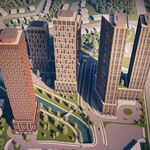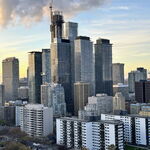***according to the renders on the link I offered above, there is supposed to be some table + chair seating
But if its there, you can't see it in your pictures.
At the end of the day the space doesn't look inviting at all.
It doesn't convey warmth or beauty, or invitation.
Nor does it appear to manage 4-season interest......
And again w/the @#$# gravel!
*****
For clarity, I've decided that this is a good example of problematic park design! LOL
I think everything is simple. Tables and chair sitting are missing because they should be secured to prevent them from disappearing at nighttime. And that would be ridiculous to chain up them, right? So, again - design for the sake of innovation. It might have been that the chairs were even delivered but are now keeping in storage.
May I say something daring?
Most people judge and distinguish a good park design from a problematic one and feel where one wants to be and not. Now everyone knows that Gh3 promotes quite a strange park design principles. Gh3 was allowed even to reproduce them. Maybe we are blind and don't see a unique, gorgeous design style, or should we suspect any wrongdoing? Why should that leave scars on the face of the city? Are there other design firms that can be questioned similarly? Will the community ever get a chance to hear from them or from the city to explain why things go like this? How to get feedback from the city? Will we have an opportunity to do that, or, overwise, it all turns to blow off some steam?
Here is another example. This below is a view of Lawren Harris Square. In the middle of the picture, we can see a bench. This bench quite obviously mounted on a slope. I believe that it is not comfortable to sit on this bench. All this place with those black tree pots, gravel floor, and the falling bench looks like a field for wrong experiments... Why does this bench look like a ship deck at a storm? Even mountain climbers at the height of 10000ft always try to find a flat surface to accommodate their tents. I tried to determine whether it is prohibited to install any seatings on a slope or not, and I couldn't find any information. That is just not mentioned anywhere globally. I can assume that this is because such a question even is not considered. The position of a hip of any human being at an angle to a backbone is unnatural, harmful, leads to rapid fatigue, and can be only temporary while doing work, sport, fight, etc., and never for resting. Although it can be seen as an exaggeration, in fact, that bench, gravel, any thoughtless design is a direct waste of our tax money.
It seems to me, as new for Toronto, while there are many positive things, some of them look abnormal, like those deserted new parks. Meanwhile, there are enough standards, policies, rules, planning organizations, societies, conferences, famous urban designers, and landscaping architects. That means something doesn't work right. What is the root of the problem?
Does anybody know and can share how urban design issues address countries like Norway, Finland, Sweden, Denmark, New Zealand, Switzerland?
Too many questions.
We can waste our lives chasing nothing or making the city better for living in reality by addressing questions directly to someone responsible. Maybe next time they will think twice.

www.wem.ca




